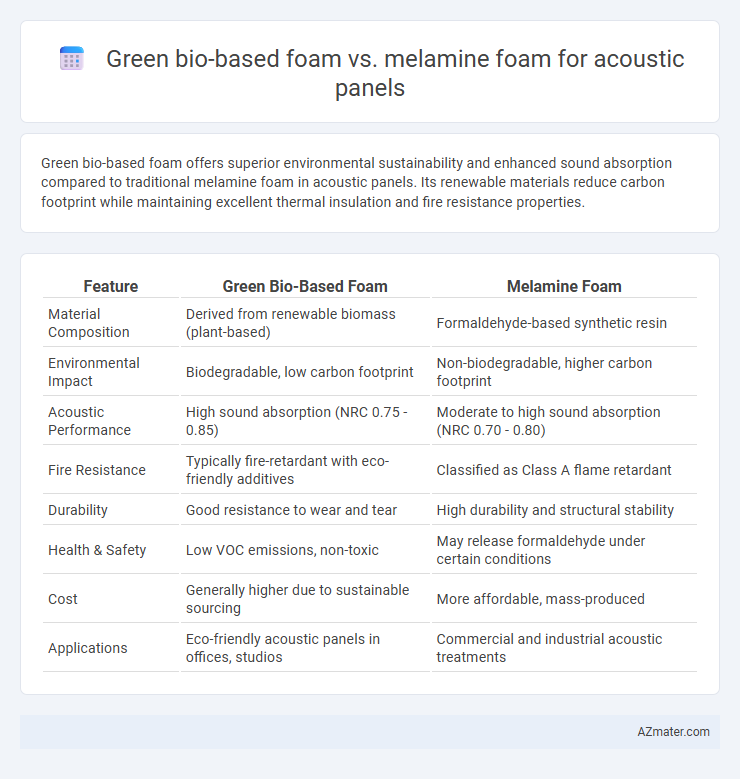Green bio-based foam offers superior environmental sustainability and enhanced sound absorption compared to traditional melamine foam in acoustic panels. Its renewable materials reduce carbon footprint while maintaining excellent thermal insulation and fire resistance properties.
Table of Comparison
| Feature | Green Bio-Based Foam | Melamine Foam |
|---|---|---|
| Material Composition | Derived from renewable biomass (plant-based) | Formaldehyde-based synthetic resin |
| Environmental Impact | Biodegradable, low carbon footprint | Non-biodegradable, higher carbon footprint |
| Acoustic Performance | High sound absorption (NRC 0.75 - 0.85) | Moderate to high sound absorption (NRC 0.70 - 0.80) |
| Fire Resistance | Typically fire-retardant with eco-friendly additives | Classified as Class A flame retardant |
| Durability | Good resistance to wear and tear | High durability and structural stability |
| Health & Safety | Low VOC emissions, non-toxic | May release formaldehyde under certain conditions |
| Cost | Generally higher due to sustainable sourcing | More affordable, mass-produced |
| Applications | Eco-friendly acoustic panels in offices, studios | Commercial and industrial acoustic treatments |
Overview of Acoustic Panel Materials
Green bio-based foam acoustic panels utilize sustainable, renewable resources such as plant fibers and biopolymers, offering eco-friendly sound absorption with low environmental impact. Melamine foam panels are composed of synthetic resin materials, providing excellent fire resistance, lightweight structure, and effective acoustic damping properties. Both materials enhance room acoustics by reducing echo and noise, but green bio-based foams emphasize sustainability while melamine foams prioritize performance and safety standards.
Introduction to Green Bio-Based Foam
Green bio-based foam, derived from renewable natural resources such as soy, corn, or algae, offers an eco-friendly alternative to traditional melamine foam used in acoustic panels. Its biodegradable and non-toxic properties enhance indoor air quality while effectively absorbing sound across a broad frequency range. The sustainable production process and superior thermal insulation make green bio-based foam a preferred choice for environmentally conscious acoustic solutions.
Introduction to Melamine Foam
Melamine foam is a lightweight, open-cell material derived from melamine resin, known for its excellent sound absorption properties and thermal insulation. It is widely used in acoustic panels due to its ability to trap and dissipate sound waves effectively, reducing echo and noise pollution. Compared to green bio-based foam, melamine foam offers superior fire resistance and durability, making it a preferred choice in commercial and industrial acoustic applications.
Environmental Impact: Bio-Based vs. Melamine
Green bio-based foam acoustic panels reduce carbon footprint through renewable, plant-derived materials and enhanced biodegradability, minimizing landfill waste and toxic runoff. Melamine foam, synthesized from non-renewable petrochemicals, emits more volatile organic compounds (VOCs) during production and disposal, posing greater environmental concerns. Life cycle assessments reveal bio-based foam offers superior ecological benefits, aligning with sustainable building certifications and eco-conscious design.
Acoustic Performance Comparison
Green bio-based foam exhibits superior sound absorption coefficients across a broader frequency range compared to melamine foam, making it highly effective for reducing mid to high-frequency noise. Its porous structure enhances acoustic dampening by trapping sound waves more efficiently, resulting in improved reverberation time reduction in enclosed spaces. Melamine foam, while lightweight and fire-resistant, typically offers less acoustic performance in low-frequency absorption, limiting its overall soundproofing capabilities.
Fire Resistance and Safety Factors
Green bio-based foam exhibits superior fire resistance compared to traditional melamine foam, as it often incorporates natural flame retardants and less toxic compounds, reducing the risk of harmful smoke and toxic gas emissions during combustion. Melamine foam, despite its wide use in acoustic panels, tends to release nitrogen oxides and other hazardous fumes when exposed to fire, posing safety concerns in enclosed spaces. Choosing green bio-based foam enhances both acoustic performance and occupant safety by combining effective sound absorption with improved fire retardancy and lower toxicity.
Durability and Longevity
Green bio-based foam for acoustic panels offers enhanced durability due to its natural, resilient materials that resist moisture and degradation over time, extending panel lifespan in humid environments. Melamine foam, while effective for sound absorption, tends to be more brittle and can deteriorate faster under mechanical stress and exposure to environmental factors. Choosing green bio-based foam ensures longer-lasting performance and sustainability in acoustic insulation applications.
Cost and Availability
Green bio-based foam offers a cost-effective and sustainable alternative to melamine foam for acoustic panels, often priced lower due to renewable raw materials and simpler manufacturing processes. Melamine foam, while widely available and known for superior fire resistance and acoustic performance, tends to be more expensive because of its chemical composition and production complexity. Availability of green bio-based foam is increasing as demand for eco-friendly materials grows, but melamine foam remains more readily accessible globally due to established supply chains.
Installation and Maintenance Considerations
Green bio-based foam offers easier installation due to its lightweight and flexible structure, allowing for quick cutting and fitting without specialized tools, whereas melamine foam is more rigid and may require precise handling to avoid breakage. Maintenance of green bio-based foam panels typically involves simple cleaning with mild detergents, benefiting from its resistant yet breathable surface, while melamine foam panels demand careful dusting or vacuuming to prevent degradation of their open-cell architecture. Both materials provide effective acoustic performance but differ significantly in user-friendliness during installation and upkeep, influencing long-term durability and cost-efficiency.
Future Trends in Sustainable Acoustic Panels
Green bio-based foam for acoustic panels significantly reduces environmental impact by utilizing renewable materials and biodegradability, aligning with increasing global demand for sustainability in construction. Melamine foam, though effective in sound absorption and fire resistance, faces scrutiny due to its petrochemical origin and limited recyclability. Innovations in green bio-based foams emphasize enhanced acoustic performance and durability, positioning them as the future trend in eco-friendly acoustic panel manufacturing.

Infographic: Green bio-based foam vs Melamine foam for Acoustic panel
 azmater.com
azmater.com